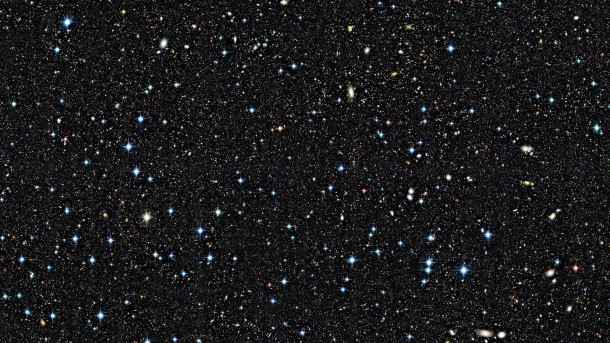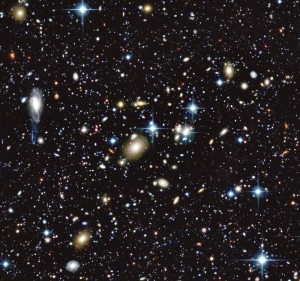
This small portion of a deep space image taken by the Canada-France-Hawaii Telscope Legacy Survey reveals thousands of galaxies yet to be explored. (Image: © CFHT/Coelum/Terapix/AstrOmatic)
Scientists have released the final version of the Canada-France-Hawaii Telescope Legacy Survey (CFHTLS), data gathered over six years which probes deep recesses of the Universe, including galaxies as far as nine billion light-years away.
This treasure trove of information will allow scientists to better study dark matter; energy; new, developing and evolving galaxies; and any solar system bodies beyond the orbit of Neptune, in a region called the Kuiper Belt.
The unique and powerful multi-color collection of astronomical images and data put together by the international team, was gathered from the Canada-France-Hawaii Telescope (CFHT) located atop the summit of Hawaii’s Mauna Kea volcano.
The project is led by French and Canadian astronomers who imaged and mapped an extremely large volume of the Universe using a ground-based, rather than space telescope, such as the Hubble.

The dome of the Canada-France-Hawaii Telescope (CFHT) is a world class 3.6-meter telescope that sits above the clouds atop Hawaii’s Mauna Kea, a dormant volcano. (Photo: © J.-C. Cuillandre (CFHT))
“The Legacy Survey has already generated a lot of results and is the most heavily cited work from CFHT,” says Raymond Carlberg of the University of Toronto, who helped with project planning and oversight.
The high-quality images allowed them to produce a large data bank which includes dark matter maps on the largest scale ever observed, according to the researchers.
The data set also contains the first high-quality light measurements which show that dark energy closely resembles the cosmological constant, which counteracts the gravitational pull of matter, something Albert Einstein predicted in his General Theory of Relativity and later thought might have been his greatest mistake.
Although dark matter and dark energy dominate the universe, they can’t be seen or identified. However, astronomers are able to measure the effect that dark energy has on the rate of the expansion of our universe.
To help scientists gain a better understanding of dark energy, the Legacy Survey team set out to precisely measure several hundred “Type Ia” supernovae, which they say are excellent standard light measurements for measuring galaxy distances.
At the heart of the Legacy Survey was a state-of-the-art, 340-Megapixel digital camera called MegaCam, that was coupled to the 3.6-meter Canada-France-Hawaii telescope in Hawaii. More than 15,000 individual MegaCam images were used to produce the survey.

This is image filled with a number of galaxies and other cosmological objects was taken from just a very small fraction of the Canada-France-Hawaii Telescope Legacy Survey (Image: ©CFHT/Coelum)
Observations began in 2003 and ended in 2009. The scientists then took three more years to precisely calibrate the huge volume of data gathered from the images.
In the course of their work, project members were able to image and map across a combined area of the heavens which is about 800 times the surface area of the full moon as seen in the sky.
The survey revealed some 38 million celestial objects, which were mostly distant galaxies in various stages of evolution.
The search for new solar system bodies beyond Neptune’s orbit, in a region called the Kuiper Belt, also proved successful. That area of space contains numerous chunks of material left over from when the solar system formed.
The astronomers were able to collect what they term “an exceptional sample” of minor bodies in that region.
A new initiative, the Canada-France Ecliptic Plane Survey, has taken over that area of study. With Legacy Survey data, as well from other telescopes, those scientists have so far been able to determine the orbits of nearly 200 Kuiper Belt objects with high-precision. Other astronomers studying the formation of our solar system are also using the Legacy Survey’s information to test various scientific models.
“The legacy will not be limited to follow-ups of the survey,” says Yannick Mellier, who leads a group of scientists contributing to the European Space Agency’s Euclid mission – a space telescope with cameras designed to accurately measure dark energy. “MegaCam and the CFHTLS truly paved the way for the Euclid space mission both from the scientific and technical aspects.”
As shown in the above video, the supernova reaches its peak very quickly (a few days) and then slowly fades out over weeks to months. At its peak, a supernova can shine brighter than all the other stars combined in the host galaxy. The animation spans about 4 months, from pre- to post-supernova status. Credit: SNLS





















Comments are closed.